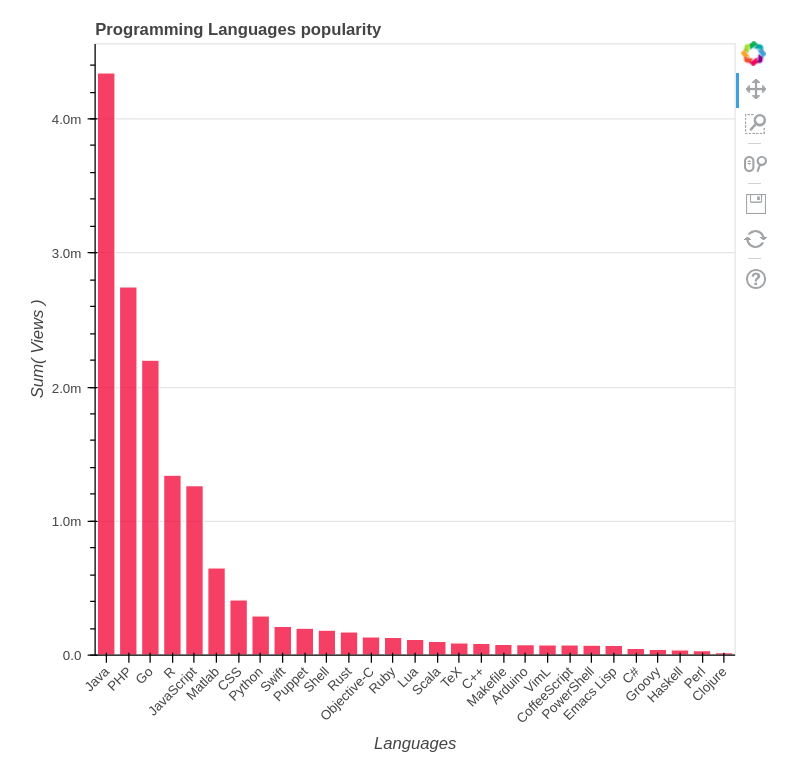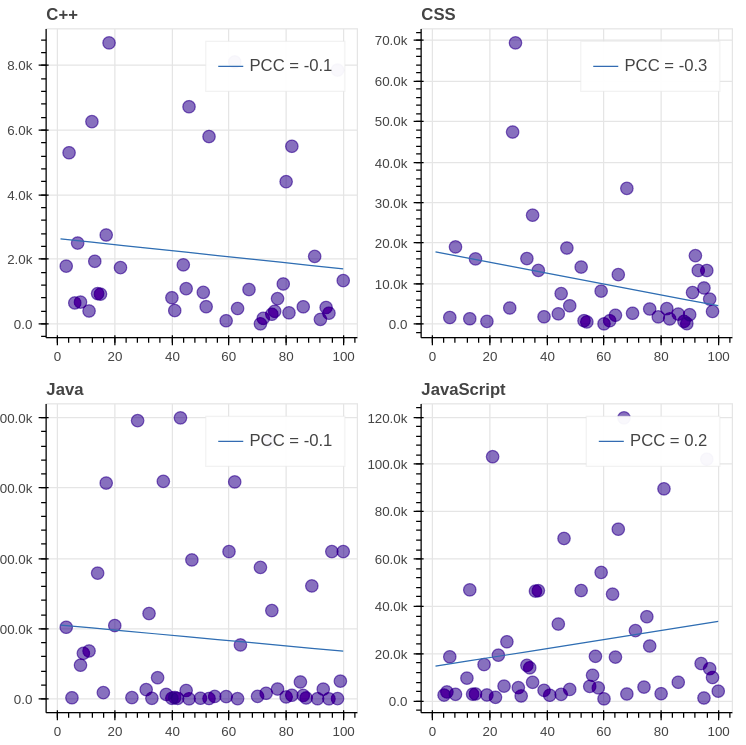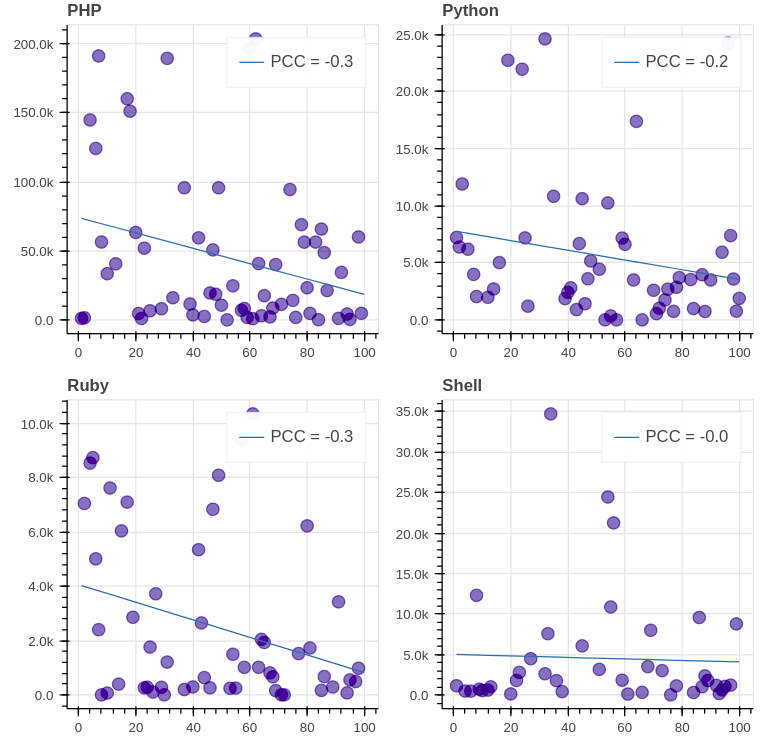mirror of
https://github.com/LCTT/TranslateProject.git
synced 2025-01-22 23:00:57 +08:00
354 lines
19 KiB
Markdown
354 lines
19 KiB
Markdown
Translating by Chao-zhi
|
||
|
||
8 best languages to blog about
|
||
============================================================
|
||
|
||
|
||
TL;DR: In this post we’re going to do some metablogging and analyze different blogs popularity against their ranking in Google. All the code is on [GitHub repo][38].
|
||
|
||
### The idea
|
||
|
||
I’ve been wondering, how many page views actually do different blogs get daily, as well as what programming languages are most popular today among blog reading audience. It was also interesting to me, whether Google ranking of websites directly correlates with their popularity.
|
||
|
||
In order to answer these questions, I decided to make a Scrapy project that will scrape some data and then perform certain Data Analysis and Data Visualization on the obtained information.
|
||
|
||
### Part I: Scraping
|
||
|
||
We will use [Scrapy][39] for our endeavors, as it provides clean and robust framework for scraping and managing feeds of processed requests. We’ll also use [Splash][40] in order to parse Javascript pages we’ll have to deal with. Splash uses its own Web server that acts like a proxy and processes the Javascript response before redirecting it further to our Spider process.
|
||
|
||
I don’t describe Scrapy project setup here as well as Splash integration. You can find example of Scrapy project backbone [here][34] and Scrapy+Splash guide [here][35].
|
||
|
||
### Getting relevant blogs
|
||
|
||
The first step is obviously getting the data. We’ll need Google search results about programming blogs. See, if we just start scraping Google itself with, let’s say query “Python”, we’ll get lots of other stuff besides blogs. What we need is some kind of filtering that leaves exclusively blogs in the results set. Luckily, there is a thing called [Google Custom Search Engine][41], that achieves exactly that. There’s also this website [www.blogsearchengine.org][42] that performs exactly what we need, delegating user requests to CSE, so we can look at its queries and repeat them.
|
||
|
||
So what we’re going to do is go to [www.blogsearchengine.org][43] and search for “python” having Network tab in Chrome Developer tools open by our side. Here’s the screenshot of what we’re going to see.
|
||
|
||

|
||
|
||
The highlighted query is the one that blogsearchengine delegates to Google, so we’re just going to copy it and use in our scraper.
|
||
|
||
The blog scraping spider class would then look like this:
|
||
|
||
```
|
||
class BlogsSpider(scrapy.Spider):
|
||
name = 'blogs'
|
||
allowed_domains = ['cse.google.com']
|
||
|
||
def __init__(self, queries):
|
||
super(BlogsSpider, self).__init__()
|
||
self.queries = queries
|
||
```
|
||
|
||
[view raw][3][blogs.py][4] hosted with
|
||
|
||
by [GitHub][5]
|
||
|
||
Unlike typical Scrapy spiders, ours has overridden `__init__` method that accepts additional argument `queries` that specifies the list of queries we want to perform.
|
||
|
||
Now, the most important part is the actual query building and execution. This process is performed in the `start_requests` Spider’s method, which we happily override as well:
|
||
|
||
|
||
```
|
||
def start_requests(self):
|
||
params_dict = {
|
||
'cx': ['partner-pub-9634067433254658:5laonibews6'],
|
||
'cof': ['FORID:10'],
|
||
'ie': ['ISO-8859-1'],
|
||
'q': ['query'],
|
||
'sa.x': ['0'],
|
||
'sa.y': ['0'],
|
||
'sa': ['Search'],
|
||
'ad': ['n9'],
|
||
'num': ['10'],
|
||
'rurl': [
|
||
'http://www.blogsearchengine.org/search.html?cx=partner-pub'
|
||
'-9634067433254658%3A5laonibews6&cof=FORID%3A10&ie=ISO-8859-1&'
|
||
'q=query&sa.x=0&sa.y=0&sa=Search'
|
||
],
|
||
'siteurl': ['http://www.blogsearchengine.org/']
|
||
}
|
||
|
||
params = urllib.parse.urlencode(params_dict, doseq=True)
|
||
url_template = urllib.parse.urlunparse(
|
||
['https', self.allowed_domains[0], '/cse',
|
||
'', params, 'gsc.tab=0&gsc.q=query&gsc.page=page_num'])
|
||
for query in self.queries:
|
||
for page_num in range(1, 11):
|
||
url = url_template.replace('query', urllib.parse.quote(query))
|
||
url = url.replace('page_num', str(page_num))
|
||
yield SplashRequest(url, self.parse, endpoint='render.html',
|
||
args={'wait': 0.5})
|
||
```
|
||
|
||
[view raw][6][blogs.py][7] hosted with
|
||
|
||
by [GitHub][8]
|
||
|
||
Here you can see quite complex `params_dict` dictionary holding all the parameters of the Google CSE URL we found earlier. We then prepare `url_template` with everything but query and page number filled. We request 10 pages about each programming language, each page contains 10 links, so it’s 100 different blogs for each language to analyze.
|
||
|
||
On lines `42-43` we use special `SplashRequest` instead of Scrapy’s own Request class, which wraps internal redirect logic of Splash library, so we don’t have to worry about that. Neat.
|
||
|
||
Finally, here’s the parsing routine:
|
||
|
||
```
|
||
def parse(self, response):
|
||
urls = response.css('div.gs-title.gsc-table-cell-thumbnail') \
|
||
.xpath('./a/@href').extract()
|
||
gsc_fragment = urllib.parse.urlparse(response.url).fragment
|
||
fragment_dict = urllib.parse.parse_qs(gsc_fragment)
|
||
page_num = int(fragment_dict['gsc.page'][0])
|
||
query = fragment_dict['gsc.q'][0]
|
||
page_size = len(urls)
|
||
for i, url in enumerate(urls):
|
||
parsed_url = urllib.parse.urlparse(url)
|
||
rank = (page_num - 1) * page_size + i
|
||
yield {
|
||
'rank': rank,
|
||
'url': parsed_url.netloc,
|
||
'query': query
|
||
}
|
||
```
|
||
|
||
[view raw][9][blogs.py][10] hosted with
|
||
|
||
by [GitHub][11]
|
||
|
||
The heart and soul of any scraper is parser’s logic. There are multiple ways to understand the response page structure and build the XPath query string. You can use [Scrapy shell][44] to try and adjust your XPath query on the fly, without running a spider. I prefer a more visual method though. It involves Google Chrome’s Developer console again. Simply right-click the element you want to get in your spider and press Inspect. It opens the console with HTML code set to the place where it’s being defined. In our case, we want to get the actual search result links. Their source location looks like this:
|
||
|
||

|
||
|
||
So, after looking at the element description we see that the <div> we’re searching for has `.gsc-table-cell-thumbnail` CSS class and is a child of the `.gs-title` <div>, so we put it into the `css`method of response object we have (line `46`). After that, we just need to get the URL of the blog post. It is easily achieved by `'./a/@href'` XPath string, which takes the `href` attribute of tag found as direct child of our <div>.
|
||
|
||
### Finding traffic data
|
||
|
||
The next task is estimating the number of views per day each of the blogs receives. There are [various options][45] to get such data, both free and paid. After quick googling I decided to stick to this simple and free to use website [www.statshow.com][46]. The Spider for this website should take as an input blog URLs we’ve obtained in the previous step, go through them and add traffic information. Spider initialization looks like this:
|
||
|
||
```
|
||
class TrafficSpider(scrapy.Spider):
|
||
name = 'traffic'
|
||
allowed_domains = ['www.statshow.com']
|
||
|
||
def __init__(self, blogs_data):
|
||
super(TrafficSpider, self).__init__()
|
||
self.blogs_data = blogs_data
|
||
```
|
||
|
||
[view raw][12][traffic.py][13] hosted with
|
||
|
||
by [GitHub][14]
|
||
|
||
`blogs_data` is expected to be list of dictionaries in the form: `{"rank": 70, "url": "www.stat.washington.edu", "query": "Python"}`.
|
||
|
||
Request building function looks like this:
|
||
|
||
```
|
||
def start_requests(self):
|
||
url_template = urllib.parse.urlunparse(
|
||
['http', self.allowed_domains[0], '/www/{path}', '', '', ''])
|
||
for blog in self.blogs_data:
|
||
url = url_template.format(path=blog['url'])
|
||
request = SplashRequest(url, endpoint='render.html',
|
||
args={'wait': 0.5}, meta={'blog': blog})
|
||
yield request
|
||
```
|
||
|
||
[view raw][15][traffic.py][16] hosted with
|
||
|
||
by [GitHub][17]
|
||
|
||
It’s quite simple, we just add `/www/web-site-url/` string to the `'www.statshow.com'` url.
|
||
|
||
Now let’s see how does the parser look:
|
||
|
||
```
|
||
def parse(self, response):
|
||
site_data = response.xpath('//div[@id="box_1"]/span/text()').extract()
|
||
views_data = list(filter(lambda r: '$' not in r, site_data))
|
||
if views_data:
|
||
blog_data = response.meta.get('blog')
|
||
traffic_data = {
|
||
'daily_page_views': int(views_data[0].translate({ord(','): None})),
|
||
'daily_visitors': int(views_data[1].translate({ord(','): None}))
|
||
}
|
||
blog_data.update(traffic_data)
|
||
yield blog_data
|
||
```
|
||
|
||
[view raw][18][traffic.py][19] hosted with
|
||
|
||
by [GitHub][20]
|
||
|
||
Similarly to the blog parsing routine, we just make our way through the sample return page of the StatShow and track down the elements containing daily page views and daily visitors. Both of these parameters identify website popularity, so we’ll just pick page views for our analysis.
|
||
|
||
### Part II: Analysis
|
||
|
||
The next part is analyzing all the data we got after scraping. We then visualize the prepared data sets with the lib called [Bokeh][47]. I don’t give the runner/visualization code here but it can be found in the [GitHub repo][48] in addition to everything else you see in this post.
|
||
|
||
The initial result set has few outlying items representing websites with HUGE amount of traffic (such as google.com, linkedin.com, Oracle.com etc.). They obviously shouldn’t be considered. Even if some of those have blogs, they aren’t language specific. That’s why we filter the outliers based on the approach suggested in [this StackOverflow answer][36].
|
||
|
||
### Language popularity comparison
|
||
|
||
At first, let’s just make a head-to-head comparison of all the languages we have and see which one has most daily views among the top 100 blogs.
|
||
|
||
Here’s the function that can take care of such a task:
|
||
|
||
|
||
```
|
||
def get_languages_popularity(data):
|
||
query_sorted_data = sorted(data, key=itemgetter('query'))
|
||
result = {'languages': [], 'views': []}
|
||
popularity = []
|
||
for k, group in groupby(query_sorted_data, key=itemgetter('query')):
|
||
group = list(group)
|
||
daily_page_views = map(lambda r: int(r['daily_page_views']), group)
|
||
total_page_views = sum(daily_page_views)
|
||
popularity.append((group[0]['query'], total_page_views))
|
||
sorted_popularity = sorted(popularity, key=itemgetter(1), reverse=True)
|
||
languages, views = zip(*sorted_popularity)
|
||
result['languages'] = languages
|
||
result['views'] = views
|
||
return result
|
||
|
||
```
|
||
|
||
[view raw][21][analysis.py][22] hosted with
|
||
|
||
by [GitHub][23]
|
||
|
||
Here we first group our data by languages (‘query’ key in the dict) and then use python’s `groupby`wonderful function borrowed from SQL to generate groups of items from our data list, each representing some programming language. Afterwards, we calculate total page views for each language on line `14` and then add tuples of the form `('Language', rank)` in the `popularity`list. After the loop, we sort the popularity data based on the total views and unpack these tuples in 2 separate lists and return those in the `result` variable.
|
||
|
||
There was some huge deviation in the initial dataset. I checked what was going on and realized that if I make query “C” in the [blogsearchengine.org][37], I get lots of irrelevant links, containing “C” letter somewhere. So, I had to exclude C from the analysis. It almost doesn’t happen with “R” in contrast as well as other C-like names: “C++”, “C#”.
|
||
|
||
So, if we remove C from the consideration and look at other languages, we can see the following picture:
|
||
|
||

|
||
|
||
Evaluation. Java made it with over 4 million views daily, PHP and Go have over 2 million, R and JavaScript close up the “million scorers” list.
|
||
|
||
### Daily Page Views vs Google Ranking
|
||
|
||
Let’s now take a look at the connection between the number of daily views and Google ranking of blogs. Logically, less popular blogs should be further in ranking, It’s not so easy though, as other factors influence ranking as well, for example, if the article in the less popular blog is more recent, it’ll likely pop up first.
|
||
|
||
The data preparation is performed in the following fashion:
|
||
|
||
```
|
||
def get_languages_popularity(data):
|
||
query_sorted_data = sorted(data, key=itemgetter('query'))
|
||
result = {'languages': [], 'views': []}
|
||
popularity = []
|
||
for k, group in groupby(query_sorted_data, key=itemgetter('query')):
|
||
group = list(group)
|
||
daily_page_views = map(lambda r: int(r['daily_page_views']), group)
|
||
total_page_views = sum(daily_page_views)
|
||
popularity.append((group[0]['query'], total_page_views))
|
||
sorted_popularity = sorted(popularity, key=itemgetter(1), reverse=True)
|
||
languages, views = zip(*sorted_popularity)
|
||
result['languages'] = languages
|
||
result['views'] = views
|
||
return result
|
||
```
|
||
|
||
[view raw][24][analysis.py][25] hosted with
|
||
|
||
by [GitHub][26]
|
||
|
||
The function accepts scraped data and list of languages to consider. We sort the data in the same way we did for languages popularity. Afterwards, in a similar language grouping loop, we build `(rank, views_number)` tuples (with 1-based ranks) that are being converted to 2 separate lists. This pair of lists is then written to the resulting dictionary.
|
||
|
||
The results for the top 8 GitHub languages (except C) are the following:
|
||
|
||

|
||
|
||

|
||
|
||
Evaluation. We see that the [PCC (Pearson correlation coefficient)][49] of all graphs is far from 1/-1, which signifies lack of correlation between the daily views and the ranking. It’s important to note though that in most of the graphs (7 out of 8) the correlation is negative, which means that decrease in ranking leads to decrease in views indeed.
|
||
|
||
### Conclusion
|
||
|
||
So, according to our analysis, Java is by far most popular programming language, followed by PHP, Go, R and JavaScript. Neither of top 8 languages has a strong correlation between daily views and ranking in Google, so you can definitely get high in search results even if you’re just starting your blogging path. What exactly is required for that top hit a topic for another discussion though.
|
||
|
||
These results are quite biased and can’t be taken into consideration without additional analysis. At first, it would be a good idea to collect more traffic feeds for an extended period of time and then analyze the mean (median?) values of daily views and rankings. Maybe I’ll return to it sometime in the future.
|
||
|
||
### References
|
||
|
||
1. Scraping:
|
||
|
||
1. [blog.scrapinghub.com: Handling Javascript In Scrapy With Splash][27]
|
||
|
||
2. [BlogSearchEngine.org][28]
|
||
|
||
3. [twingly.com: Twingly Real-Time Blog Search][29]
|
||
|
||
4. [searchblogspot.com: finding blogs on blogspot platform][30]
|
||
|
||
3. Traffic estimation:
|
||
|
||
1. [labnol.org: Find Out How Much Traffic a Website Gets][31]
|
||
|
||
2. [quora.com: What are the best free tools that estimate visitor traffic…][32]
|
||
|
||
3. [StatShow.com: The Stats Maker][33]
|
||
|
||
--------------------------------------------------------------------------------
|
||
|
||
via: https://www.databrawl.com/2017/10/08/blog-analysis/
|
||
|
||
作者:[Serge Mosin ][a]
|
||
译者:[译者ID](https://github.com/译者ID)
|
||
校对:[校对者ID](https://github.com/校对者ID)
|
||
|
||
本文由 [LCTT](https://github.com/LCTT/TranslateProject) 原创编译,[Linux中国](https://linux.cn/) 荣誉推出
|
||
|
||
[a]:https://www.databrawl.com/author/svmosingmail-com/
|
||
[1]:https://bokeh.pydata.org/
|
||
[2]:https://bokeh.pydata.org/
|
||
[3]:https://gist.github.com/Greyvend/f730ccd5dc1e7eacc4f27b0c9da86eee/raw/4ebb94aa41e9ab25fc79af26b49272b2eff47e00/blogs.py
|
||
[4]:https://gist.github.com/Greyvend/f730ccd5dc1e7eacc4f27b0c9da86eee#file-blogs-py
|
||
[5]:https://github.com/
|
||
[6]:https://gist.github.com/Greyvend/f730ccd5dc1e7eacc4f27b0c9da86eee/raw/4ebb94aa41e9ab25fc79af26b49272b2eff47e00/blogs.py
|
||
[7]:https://gist.github.com/Greyvend/f730ccd5dc1e7eacc4f27b0c9da86eee#file-blogs-py
|
||
[8]:https://github.com/
|
||
[9]:https://gist.github.com/Greyvend/f730ccd5dc1e7eacc4f27b0c9da86eee/raw/4ebb94aa41e9ab25fc79af26b49272b2eff47e00/blogs.py
|
||
[10]:https://gist.github.com/Greyvend/f730ccd5dc1e7eacc4f27b0c9da86eee#file-blogs-py
|
||
[11]:https://github.com/
|
||
[12]:https://gist.github.com/Greyvend/f730ccd5dc1e7eacc4f27b0c9da86eee/raw/4ebb94aa41e9ab25fc79af26b49272b2eff47e00/traffic.py
|
||
[13]:https://gist.github.com/Greyvend/f730ccd5dc1e7eacc4f27b0c9da86eee#file-traffic-py
|
||
[14]:https://github.com/
|
||
[15]:https://gist.github.com/Greyvend/f730ccd5dc1e7eacc4f27b0c9da86eee/raw/4ebb94aa41e9ab25fc79af26b49272b2eff47e00/traffic.py
|
||
[16]:https://gist.github.com/Greyvend/f730ccd5dc1e7eacc4f27b0c9da86eee#file-traffic-py
|
||
[17]:https://github.com/
|
||
[18]:https://gist.github.com/Greyvend/f730ccd5dc1e7eacc4f27b0c9da86eee/raw/4ebb94aa41e9ab25fc79af26b49272b2eff47e00/traffic.py
|
||
[19]:https://gist.github.com/Greyvend/f730ccd5dc1e7eacc4f27b0c9da86eee#file-traffic-py
|
||
[20]:https://github.com/
|
||
[21]:https://gist.github.com/Greyvend/f730ccd5dc1e7eacc4f27b0c9da86eee/raw/4ebb94aa41e9ab25fc79af26b49272b2eff47e00/analysis.py
|
||
[22]:https://gist.github.com/Greyvend/f730ccd5dc1e7eacc4f27b0c9da86eee#file-analysis-py
|
||
[23]:https://github.com/
|
||
[24]:https://gist.github.com/Greyvend/f730ccd5dc1e7eacc4f27b0c9da86eee/raw/4ebb94aa41e9ab25fc79af26b49272b2eff47e00/analysis.py
|
||
[25]:https://gist.github.com/Greyvend/f730ccd5dc1e7eacc4f27b0c9da86eee#file-analysis-py
|
||
[26]:https://github.com/
|
||
[27]:https://blog.scrapinghub.com/2015/03/02/handling-javascript-in-scrapy-with-splash/
|
||
[28]:http://www.blogsearchengine.org/
|
||
[29]:https://www.twingly.com/
|
||
[30]:http://www.searchblogspot.com/
|
||
[31]:https://www.labnol.org/internet/find-website-traffic-hits/8008/
|
||
[32]:https://www.quora.com/What-are-the-best-free-tools-that-estimate-visitor-traffic-for-a-given-page-on-a-particular-website-that-you-do-not-own-or-operate-3rd-party-sites
|
||
[33]:http://www.statshow.com/
|
||
[34]:https://docs.scrapy.org/en/latest/intro/tutorial.html
|
||
[35]:https://blog.scrapinghub.com/2015/03/02/handling-javascript-in-scrapy-with-splash/
|
||
[36]:https://stackoverflow.com/a/16562028/1573766
|
||
[37]:http://blogsearchengine.org/
|
||
[38]:https://github.com/Databrawl/blog_analysis
|
||
[39]:https://scrapy.org/
|
||
[40]:https://github.com/scrapinghub/splash
|
||
[41]:https://en.wikipedia.org/wiki/Google_Custom_Search
|
||
[42]:http://www.blogsearchengine.org/
|
||
[43]:http://www.blogsearchengine.org/
|
||
[44]:https://doc.scrapy.org/en/latest/topics/shell.html
|
||
[45]:https://www.labnol.org/internet/find-website-traffic-hits/8008/
|
||
[46]:http://www.statshow.com/
|
||
[47]:https://bokeh.pydata.org/en/latest/
|
||
[48]:https://github.com/Databrawl/blog_analysis
|
||
[49]:https://en.wikipedia.org/wiki/Pearson_correlation_coefficient
|
||
[50]:https://www.databrawl.com/author/svmosingmail-com/
|
||
[51]:https://www.databrawl.com/2017/10/08/
|